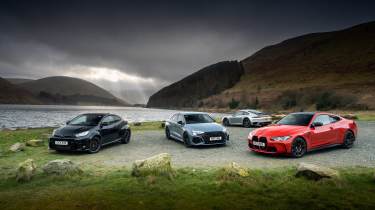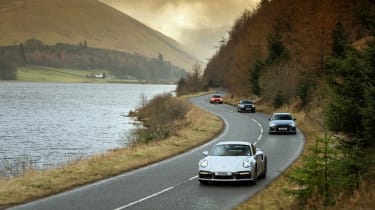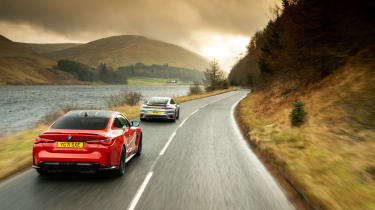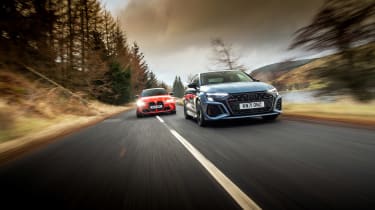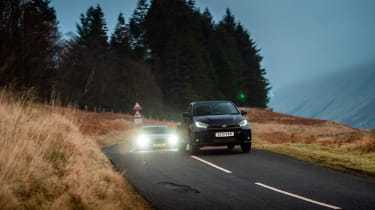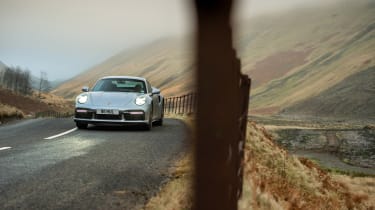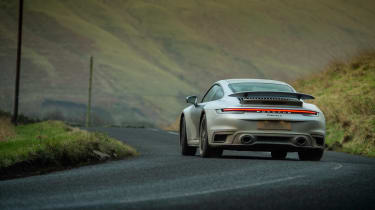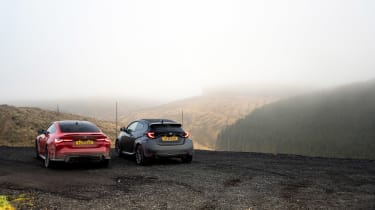Porsche 911 Turbo v Audi RS3 v BMW M4 v Toyota GR Yaris – 4WD mega test
This time of year it feels like the only fast cars on the road feature four-driven wheels. We pitch our four favourite all-wheel drive models against each other, and the conditions...
I like John Barker. He’s a great guy. Unassuming, unshakeably calm and with a dry wit of razor sharpness. A couple of beers with John is a very fine time indeed. However, he is literally the last person on earth you want bearing down on you in a Toyota GR Yaris on a freezing cold morning as a bumpy, narrow, glistening road disappears around a sharp right ahead. Especially when you’re in a much more powerful, much faster car. Something like the BMW M4 that I’m currently driving, heart in mouth and so preoccupied with what’s going on behind that I swear I can hear the demented warble of the Toyota’s three-cylinder motor filling the cabin.
On another day I’d probably indicate left timidly and let the Yaris romp past in a ball of celebratory spray, the four-wheel-drive equivalent of a bootful of sand in the face. But not today. This is a BMW M4 Competition xDrive. It’s bigger, heavier and much more powerful than the Yaris and, whilst the conditions suggest those things could be a huge disadvantage, the xDrive system evens things up by allowing the German car to utilise its natural acceleration advantage. So I relax just a little bit and decide to see if a four-wheel-drive BMW M4 just might be the very best sort of BMW M4.
Maybe a four-wheel-drive anything is the best version of itself in 2022? Lament as we might, cars continue to get bigger and the spiralling power and torque outputs show no sign of abating. In a world where it’s the norm to have something close to peak torque available from 1500 to 5000rpm, with huge performance right there for the taking with little or no effort, perhaps four-wheel drive is just a necessary evil? When nuances of steering feel are scarce, when grip levels are so high that real ‘handling’ is almost inaccessible at sensible speeds and when the multi-layered experience of driving is so often reduced to point, squirt and repeat, why not make those moments as vivid, secure and forceful as can be?
> BMW M4 Competition xDrive review
It’s a powerful argument, but I’m not ready to give up on the thrill of driving just yet. There are still brilliant, tactile experiences to be had out there and I have a hunch that four-wheel drive isn’t a hindrance at all. Instead, it’s coming into its own. Perhaps four-wheel drive has become so effective and so invisible that it adds to the experience? Harnessing power but not at the expense of interaction. Maybe because having four driven wheels lessens the reliance on traction and stability control systems, it actually enhances the sense of involvement?
The next couple of days will interrogate both theories and ask many more questions besides. Mostly, we’re here to have fun. It’s bitingly cold and these Scottish Borders roads are really, really treacherous. Clearly, the Yaris hasn’t noticed. A 911 Turbo S and Audi’s fresh new RS3 are emerging from a petrol station just a few miles behind us. Will they fare so well? More questions. For now, I just don’t want to hold that bloody Toyota up…
Picking the cars was easy. The Yaris is the traditional giant-killer. It uses four-wheel drive to make the most of its performance and has that tough, no-nonsense WRC appeal. It really is an Integrale, Impreza or Evo for these times and has been a huge sales success, too. The Yaris perfectly illustrates the pent-up demand for authentic, affordable performance cars. The only problem is that the giants just get bigger and 257bhp isn’t even where those rally icons were over a decade ago. There are (many) front-drivers with more potency and unbelievable all-weather speed. Does the formula still add up? Does four-wheel drive give it an edge?
The Porsche is a different animal. As soon as the 911 Turbo adopted front driveshafts with the 993 generation, its potential was realised. ‘Turbo’ no longer struck fear into the hearts of drivers and instead it decimated traditional supercars with a blend of the 911’s inherent agility, feedback and usability backed up with a new kind of utterly explosive performance. It’s been beating up wedges of aluminium and carbonfibre ever since.
The 992 Turbo S is the most powerful yet, with 641bhp and 590lb ft. It still covers ground at an alarming rate with assured ease. It has an edge over pretty much anything; that goes without saying. But as the 911’s traditional strengths are ever so slightly diluted generation on generation, perhaps the Turbo S – always a car that sacrificed delicacy for devastating efficiency – has gone beyond the old steroidal 911 feel to a different sort of car entirely? All power, all efficiency and barely a trace of the old spirit. Does it remove the driver too far from the heart of the experience?
So far we’re not really treading new ground here. However, the launch of Audi’s new RS3 and the BMW M4 xDrive is a significant moment. The RS3 is based on a transverse-engine/front-drive mechanical configuration but uses every piece of tech possible in its switch to four-wheel drive to hide those roots. It wants to feel very obviously 4WD and have a much broader dynamic range than a front-drive equivalent. Conversely, the M4 xDrive wants to keep the overtly rear-drive feeling of any other M3/M4 – the car that probably defines the rear-drive coupe for most of us – whilst enhancing security in low-grip conditions.
So we have giant-killer, everything-killer, one car desperate to create a new identity and one hoping to hold on to its old iconic status. This is undoubtedly the stage on which to exercise them, too. It’s not raining but moisture hangs in the air and the road is slimy, bumpy and seems to constrict ever tighter every few miles. Sound like Yaris country? Or Impreza country or Evo country for that matter? Absolutely. The GR channels those old heroes. The RS3 has its own icon to summon. Can a five-cylinder Audi with a trick torque-vectoring rear differential reconnect with its own distant past? Perhaps. What’s the M4 channelling? I’m not so sure… but it feels pretty damn good.
Oh, I can tell it’s slippery out there and I’m on high alert, but the BMW feels unbelievably secure and yet wonderfully fluid. There are no surprises. If I ask too much on turn-in there’s gentle push that quickly stabilises under power. When the corner opens out, a little more gas swings the tail momentarily wide but it’s so easy to blend back into line with steering and throttle. I’m sure the xDrive system is working furiously beneath me but I can’t detect power being manipulated between each axle. I’m empowered and the car is unfazed. What a motor, too. The 3-litre twin-turbocharged straight-six produces 503bhp at 6250rpm and 479lb ft from 2750 to 5500rpm and it feels greedy for the cold, dense air. Right now, I can’t imagine even the Turbo S feeling that much quicker between the corners. And yet still the Yaris little-by-little reels me in.
‘The grip the GR finds is astonishing,’ Barker reports once we’ve reached our meeting point. ‘There’s such a lazy, reluctant feel to the Yaris initially; the steering feels properly weighty, a bit treacly and the car responds reluctantly; the shift is mechanical and hefty, the beat of the triple soft and heavy… but chuck it at a corner and give it the beans and instantly this all drops away.’ John, just like me, has been a Yaris admirer rather than a full-blown fan up until now. It seems these conditions are revealing new layers. ‘Absolutely, it’s perfect for the car up here.’
This little tussle has been fascinating. Mostly because it reveals that there’s only so much performance you can safely extract on the road, four-wheel drive or not. If you’re capable of getting the most from a Yaris GR then nothing is getting away. Not today. Later, I’m reminded of this once again when the roles are reversed and John is ahead in the Turbo S. He can momentarily gap me out of turns, but the truth is that only recklessness would really allow you to take full advantage of the Turbo’s on-paper advantages. Giant killer? Maybe not quite, not this time. But the Yaris will hang with the biggest beast you can find.
If quantity of performance isn’t quite as relevant as we’d all like to imagine, then can four-wheel drive also up the quality quotient? The Turbo S seems the very best place to answer that question. As I’ve already said, even the committed will only scratch the surface of the 911’s outright ability on the road, so it had better entertain and enthral at less custodial speeds. Now, a bit of housekeeping. Firstly, 911 HUL is wearing Michelin Pilot Alpin winter tyres, and is the only car here equipped with such rubber. More significantly still, this Turbo S isn’t fitted with the sports suspension that so confused us at eCoty 2020. With a little more ride height (10mm) and a lot more compliance, we’re hoping it will rediscover the any-road omnipotence of old. The corduroy interior trim and green backlit dials of the Heritage Design Package certainly draw inspiration from 911s gone by.
As you might expect, the Turbo S gets all the basics just so. The driving position is superb and highly adjustable, the steering wheel feels really small and the whole environment is special and seems to shrink the width of the Turbo S right down. It may be big for a 911, but it doesn’t feel it from the driver’s seat. Love the retro green dials, too.
Just a few miles is enough to know that the standard chassis is fantastically poised and capable of soothing away all but the nastiest and most ragged tarmac. The unshakeable composure married to endless, elastic performance from the 3.7-litre flat-six creates an extraordinary sense of momentum. The Turbo S really does feel unstoppable and unconcerned with earthly matters such as wicked camber changes, freefall hidden dips or, indeed, the laws of physics. You don’t drive it safe in the knowledge that you’ve got an e-diff on the rear axle supplemented by a multi-plate clutch to transfer power to the front wheels (up to 368lb ft can be directed forwards), nor do you sense that the power flow is constantly changing. For all the technology and hardware, the Turbo S is entirely intuitive and entirely a 911 in the way it behaves.
Ultimately, that means the Porsche is fantastically adjustable, blessed with phenomenal balance and, should you venture to those sky-high limits, allows the driver total freedom to manipulate the way it attacks any corner. The four-wheel-drive dream. Sadly, though, it’s not all rosy. The Turbo S lives much of its life well below those amazing heights and simply doesn’t come alive. The steering – the very lifeblood of the 911 driving experience – is almost mute in these slick, low mu conditions. Perhaps this and the slower than expected front-end response is partly due to the fitment of winter tyres, but somehow the Turbo S doesn’t communicate its incredible capabilities nor immerse you in the way it’s picking apart the road. Adam Towler, who can sense my slight unease in the Porsche, tends to agree: ‘I think part of it is that, as an experience, it only really comes alive when you’re going at Mach 3. Otherwise it’s quite ordinary. And Mach 3 in the Turbo S is really moving.’
The winter tyres certainly erode brake feel and tend to get the ABS triggering very early, but our collective feeling is that even different tyres wouldn’t solve all of the problems. The Turbo S is supremely capable and, ironically, I suspect it would be fantastic on track, but on the road it impresses rather than enchants. John is a fan but still can’t quite find the love: ‘This Turbo S has the traditional Turbo bandwidth, with low-speed comfort and fine high-speed control, and for extra tautness you can press the dash button – a reverse of the Ferrari damper button!
‘Damping firmed, even along the roller-coaster road we drove on today, the Turbo feels beautifully controlled,’ he continues. ‘So, the one area where the winters would benefit the Turbo based on previous eCoty experience is where this chassis spec doesn’t need it, and where it does need it – steering response and feel – the soft tread-blocks ensure it is missing.’
Steering response is not something that the RS3 is lacking. This is a fascinating car that tries to put right the wrongs of previous front-drive platforms converted to four-wheel drive with its new RS Torque Splitter rear differential. It’s a similar system to the one employed by the last Focus RS (although supplied by Magna rather than being GKN’s Twinster system) whereby the rear diff is replaced by a simple bevel gear with a wet clutch either side of it for each rear driveshaft. Manipulating the clutches allows for precise torque distribution and torque vectoring to overspeed the outside wheel during cornering (to reduce understeer). The RS Torque Splitter can deliver 100 per cent of the rear axle’s power to just one wheel if necessary. However, only very extreme circumstances (think sheet ice) see more than 50 per cent of overall power diverted to the rear axle.
The rest of the package is as you might expect. The superb EA855 2.5-litre in-line five-cylinder engine is mounted transversely and produces 394bhp and 369lb ft via a seven-speed dual-clutch transmission. Rather incredibly, when equipped with the optional RS Dynamic Pack (£5500) consisting of ceramic brakes, RS adaptive suspension and a sports exhaust, the RS3 can reach 180mph, knock out 0-62mph in 3.8 seconds and scurry around the Ring in 7:40.74. It costs from £55,405 in saloon form, although the car tested here is closer to £70,000. A lot of money, sure, but a lot of capability, too.
Up here the RS3’s new party piece of a supple, subtle ride – so welcome on the motorway schlep – isn’t quite as alluring, and when you’re trying to hang with a Turbo S you’ll need everything, including the dampers, dialled up to Dynamic to keep its 1575kg in check. The five-cylinder engine requires some revs but delivers serious pace, even if the seven-speed ’box feels a generation or two behind the times. The tiny, afterthought paddles don’t help the situation. Fortunately, there’s a lot to digest here and so the insubstantial click for gearshifts is little more than a momentary distraction.
The big headlines are very positive. The RS3 doesn’t understeer. At all. Not on the road, anyway. It has fine body control, fast reactions and its front-drive roots neither intrude nor hinder its pace and balance. Oversteer is there for the taking, but it’s mostly benign and controllable. And the engine is really soulful and entertaining when it’s fully wound-up. It’s in the detail that the RS3 struggles. The steering is light on texture and, more importantly, the response is inconsistent. Funnily enough, I think this is due to the trick rear differential. Clearly, the torque vectoring is powerful and it can create a fantastic sense of pointiness. However, because the diff reacts based on a vast amount of information, you’re not always entirely sure what it’s going to do. So in certain corners the RS3 turns beautifully and with very little steering lock, but the next curve could require more lock as the outside rear wheel isn’t driven so hard. Because you’re always second-guessing the car, progress is jagged and can feel unnatural.
Moreover, because the balance is ‘managed’ so aggressively you can’t ease yourself into the chassis. As John later remarks, ‘Even in the super-grippy Yaris, you get the measure of the car and how it responds and, when you want, you can press it a bit harder and it’ll smudge wide. This might be just what you need to fine-tune your line. In the RS3 you add a bit more lock and the car gives you more turning. It might make some engineer happy by raising the lateral G but it feels unnatural and wrong-footing.’ The irony of complaining that the RS3 has too much front grip is not lost on us. However, there is something undeniably synthesised about its balance. It’s like the RS3 has rear-steering but it only activates 50 per cent of the time.
So we have the Yaris GR. Authentic, effective and unbelievably grippy but perhaps a little prescriptive and uptight. What an engine, though! A 911 Turbo S with eye-watering capabilities and fundamentally brilliant control and balance but a paucity of tactile thrills and involvement, and an Audi that has genuine breadth of ability and an adjustable balance but at times manages to baffle. Each has shrugged off the conditions and shown the inherent traction advantages of four-wheel drive but none has quite delivered the pure excitement that we seek, nor proven that four is inherently better than two.
The M4 xDrive takes elements from each to create a brilliantly resolved whole. First impressions are of a surprisingly big, low-slung and slightly intimidating car on these often narrow, craggy roads. The ride doesn’t have the stunning control of the 911, either. Pretty soon those concerns melt away, though.
Not because of torque-vectoring cleverness or a sense of invincible grip and the carefree way you can throw it into corners. The M4 xDrive doesn’t celebrate its four-wheel-drive system by making it front and centre of the driving experience, but nor does it hide it away. The key to its appeal is the way it integrates the benefits of a driven front axle into a sharp, responsive and inherently interactive driving experience. It really does tick so many boxes. As Towler notes, ‘It used to be that the 911 Turbo was the ultimate all-weather, cross-country machine, but this new M4 makes you wonder why you’d need the Porsche.’
There are some faults, as Barker explains. ‘After the Turbo S, the first few hundred yards illustrate just how solidly built and refined the Porsche is. The BMW sounds much more open and its ride is hard and coarse in town, and the fat wheel and heavier steering weights make it feel a bit dull. But only at first…’
Soon the immense performance, which feels almost a match for the Porsche, and the way the chassis communicates the surface and the grip levels available really hook you into the experience. It seems the most natural thing in the world to start pushing hard into turns and then quickly loading up the drivetrain with torque. The xDrive responds just as you’d expect and the balance feels so malleable, so alive. The same is true of the rear-drive M4 but you’d never dare drive quite so quickly in the wet and I love the feeling of the tail slipping wide but the slide being easily cut short as the fronts start to share the load. You don’t feel the system working, but the body language of the car is just a little more ruthless and efficient than the rear-driver.
Of course, it also provides such a degree of configurability that you can almost tailor the M4 to your mood. Towler and Barker both love this part of its character. ‘It gives so many options!’ enthuses Adam. ‘Four-wheel-drive security, or 4WD Sport, where you can have the traction control off, enjoy it sliding, but still have amazing drive. Or you can go 2WD and use the variable traction control.’ It is an astonishingly versatile system. John has perhaps gone into fantasyland but his imagination is clearly fired by the M4 when he says, ‘What a breadth of traction options xDrive offers. From total four-wheel-drive traction with DSC, all the way to rear drive with the M slip control dialled to zero. Imagine the fun you could have on a frozen lake circuit, making it go as fast as possible in each configuration.’
A frozen lake would be nice, but a slithery road in Scotland will do for me. The M4 xDrive is a heavy car but most of the time you don’t know it. Just the occasional moment of the body floating or crashing into the bumpstops betrays the mass and the forces at work, but mostly it feels agile, keen and totally up for whatever the road throws its way. The steering is relatively light and transmits decent feedback, the engine is a real monster and the coupe feels just a shade sharper than our M3 long-termer. Sounds better, too. Most of all it feels like all the benefits of four-wheel drive have been heaped on an already excellent chassis. We’d have it over the rear-drive car, no question.
We arrived here with many questions about the benefits of four-wheel drive in the context of spiralling power outputs and the trend towards bigger, heavier cars. We leave with one very simple answer. Four-wheel drive is not a cure, it does not necessarily increase enjoyment or interactivity. However, when done right – most notably in the Yaris GR and particularly the M4 xDrive – it can open up new dynamic possibilities, create unique driving experiences and, let’s be honest, kick some serious ass on a bumpy, streaming wet, mud-splattered road. Same as it ever was. Only more so.
Now, where’s that frozen lake that John was talking about…
This all-wheel drive mega test was first featured in evo 295. For the latest issue, or to subscribe click here to go to our online evo shop.
Specs
| Toyota GR Yaris Circuit Pack | Audi RS3 Saloon | BMW M4 Competition xDrive | Porsche 911 Turbo S | |
| Engine | In-line 3-cyl, 1618cc, turbocharged | In-line 5-cyl, 2480cc, turbocharged | In-line 6-cyl, 2993cc, twin-turbo | Flat-six, 3745cc, twin-turbo |
| Power | 257bhp @ 6500rpm |
394bhp @ 5600-7000rpm | 503bhp @ 6250rpm | 641bhp @ 6750rpm |
| Torque | 265lb ft @ 3000-4600rpm | 369lb ft @ 2250-5600rpm | 479lb ft @ 2750-5500rpm | 590lb ft @ 2500-4000rpm |
| Weight | 1280kg | 1575kg | 1775kg | 1640kg |
| Power-to-weight | 204bhp/ton | 254bhp/ton | 288bhp/ton | 397bhp/ton |
| 0-62mph | 5.5sec | 3.8sec | 3.5sec | 2.7sec |
| Top speed | 142mph | 155mph (180mph optional) | 155mph (limited) | 205mph |
| Basic price | £33,495 | £55,405 | £79,775 | £155,970 |
| evo rating | 5 | 4 | 5 | 4.5 |
evo Reviews

